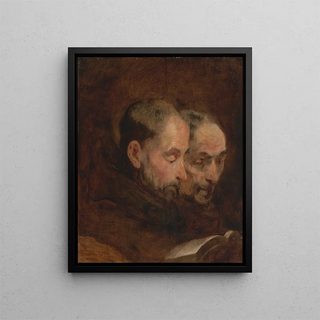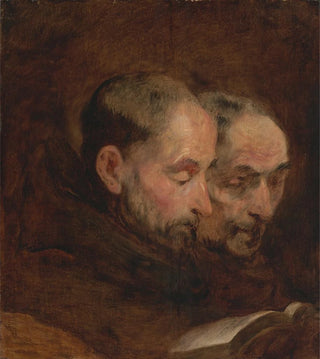Art print | Copy after a traditionally attributed Van Dyck painting depicting Two monks reading - Thomas Gainsborough


View from behind

Frame (optional)
In the world of art, some works transcend their era to become timeless symbols of human creativity. The art print based on a painting traditionally attributed to Van Dyck depicting Two monks reading - Thomas Gainsborough is a striking example. This piece, which evokes centuries of reflection and contemplation, immerses us in the universe of baroque painting, where light and shadow dance across the faces of the characters. By contemplating this scene, the viewer is invited to reflect on knowledge, spirituality, and the contemplative life of the monks, while admiring the technical virtuosity of the artist.
Style and uniqueness of the work
The stylistic richness of this work lies in its ability to capture the very essence of monastic life. The two monks, immersed in reading, seem absorbed in a world of thoughts and reflections. The treatment of drapery, the finesse of details, and the depth of colors testify to exceptional mastery. Gainsborough, although often associated with landscapes and portraits, demonstrates here a sensitivity to light reminiscent of the great Flemish masters. The composition is carefully balanced, each element arranged to guide the viewer’s eye toward the heart of the scene. This painting does not merely depict human figures; it evokes an atmosphere of serenity and wisdom, inviting silent contemplation.
The artist and his influence
Thomas Gainsborough, born in 1727, is an iconic figure of 18th-century Britain. Although renowned for his portraits of the English aristocracy, his interest in landscape and genre scenes also marked his work. Inspired by earlier masters like Van Dyck, Gainsborough managed to fuse different influences to create a distinctive style that combines realism and romanticism. His approach to color and light had a significant impact on his contemporaries and paved the way for many artists. By revisiting classical works, Gainsborough does not merely reproduce; he reinterprets, offering a new perspective on universal themes. His legacy endures,

Matte finish

View from behind

Frame (optional)
In the world of art, some works transcend their era to become timeless symbols of human creativity. The art print based on a painting traditionally attributed to Van Dyck depicting Two monks reading - Thomas Gainsborough is a striking example. This piece, which evokes centuries of reflection and contemplation, immerses us in the universe of baroque painting, where light and shadow dance across the faces of the characters. By contemplating this scene, the viewer is invited to reflect on knowledge, spirituality, and the contemplative life of the monks, while admiring the technical virtuosity of the artist.
Style and uniqueness of the work
The stylistic richness of this work lies in its ability to capture the very essence of monastic life. The two monks, immersed in reading, seem absorbed in a world of thoughts and reflections. The treatment of drapery, the finesse of details, and the depth of colors testify to exceptional mastery. Gainsborough, although often associated with landscapes and portraits, demonstrates here a sensitivity to light reminiscent of the great Flemish masters. The composition is carefully balanced, each element arranged to guide the viewer’s eye toward the heart of the scene. This painting does not merely depict human figures; it evokes an atmosphere of serenity and wisdom, inviting silent contemplation.
The artist and his influence
Thomas Gainsborough, born in 1727, is an iconic figure of 18th-century Britain. Although renowned for his portraits of the English aristocracy, his interest in landscape and genre scenes also marked his work. Inspired by earlier masters like Van Dyck, Gainsborough managed to fuse different influences to create a distinctive style that combines realism and romanticism. His approach to color and light had a significant impact on his contemporaries and paved the way for many artists. By revisiting classical works, Gainsborough does not merely reproduce; he reinterprets, offering a new perspective on universal themes. His legacy endures,






